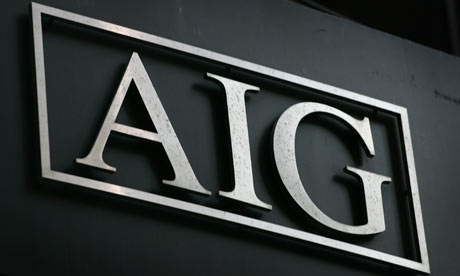
Prudential's billions will still leave AIG with a huge bailout debt to the US taxpayer. Photograph: Mark Lennihan/AP
A few billion pounds from the man from the Pru will help. But even after offloading its Asian business, AIA, to Britain's Prudential for $35.5bn (£23bn), the US insurer AIG faces an epic struggle to pay back the vast amount of money it received in a contentious bailout from American taxpayers.
In three separate emergency injections of funding at the height of the credit crunch, AIG was handed $180bn by US authorities to avert a collapse considered likely to create a knock-on panic at the heart of the financial system. As a result, the US public owns 80% of the once-mighty insurer.
"I don't think it's responsible to say yet with certainty that the US taxpayer will or won't take a bath on AIG," said Bill Bergman, an insurance analyst at Chicago-based research firm Morningstar.
AIG is beginning to show signs of improvement in revenue as customers, once scared by the possibility of bankruptcy, return to the insurer. But liabilities keep mounting in the company's core casualty business, which indemnifies individuals and companies against damage to themselves and their properties.
"They appear to have stopped the bleeding on incoming premiums," said Bergman. "But they're pretty highly leveraged to the housing market and the credit market. Any further deterioration there is going to be a problem."
At the core of AIG's original implosion was its financial products arm, largely run out of a Mayfair office in London, which wrote billions of dollars of credit default swaps protecting financial institutions against default by trading partners. Once considered low-risk, these blew up spectacularly when the US mortgage market collapsed. In Britain, the Serious Fraud Office is probing the division, once characterised by the Federal Reserve boss Ben Bernanke as a "hedge fund … attached to a large and stable insurance company".
AIG's financial products arm is being wound down and other businesses are on the auction block to pay back bailout funds, although the continuing recession has made it difficult to get decent prices. AIG has sold its US car insurance business, its Tokyo headquarters building, and a reinsurance division for a total of nearly $6bn. It has struck a deal to sell a Taiwanese operation and is negotiating to sell a foreign life insurance arm for a possible $15bn to MetLife.
The company lost $10.9bn in 2009 – a hefty sum, but a significant improvement on its $99bn deficit in 2008. New boss Robert Benmosche, who became chief executive in August and condemned criticism of the company from "lynch mobs with pitchforks", is widely credited with steering AIG towards calmer waters.
To avoid the stigma of government support, the name AIG has been dropped from many businesses. The company's property and casualty business in the US is now known as Chartis. AIG's life and retirement insurances businesses in the US still have $240bn of assets, 16m customers and 300,000 staff – but the company is unlikely ever to reclaim the global dominance it once enjoyed.
No comments:
Post a Comment